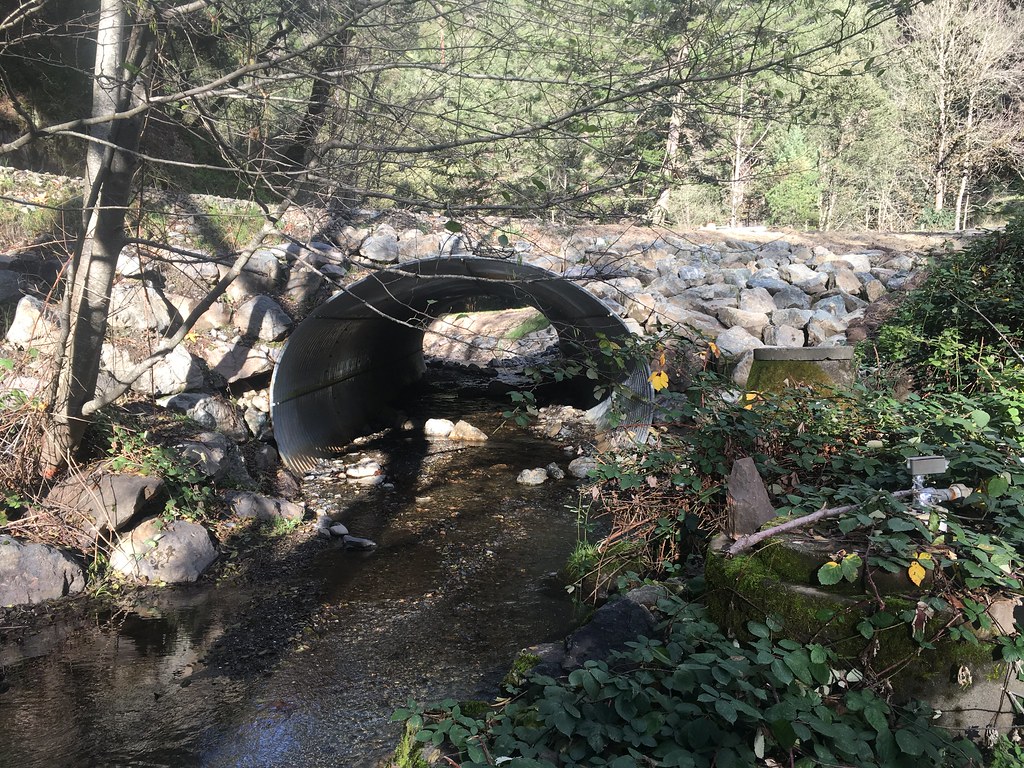Sharber-Peckham Fish Passage Project
Location of Project: 40º53’45”N Lat, 123º33’38”W Long
Description of Project: The proposed project will replace an undersized culvert which has created a migration barrier to anadromous fish species on Sharber/Peckham Creek. This barrier prevents access to upstream spawning and rearing habitat for threatened Southern Oregon/Northern California Coasts (SONCC) coho salmon (Oncorhynchus kisutch), Upper Klamath-Trinity Rivers Chinook salmon (Oncorhynchus tshawytscha) and Klamath Mountains Province Steelhead trout (Oncorhynchus mykiss). Removal of this barrier would allow use of approximately 1.2 miles of high quality spawning, over-wintering and summer rearing habitat within this tributary. Currently, anadromous fish can access only the lower 0.2 miles of Sharber/Peckham Creek. The project area is within designated critical habitat and Essential Fish Habitat for SONCC coho salmon. Deliverables of the proposed project will include a final construction and monitoring report documenting the success of the project.
This project will address spawning, rearing and fish passage requirements by removing the impassable culvert and installing a 12 foot x 14 foot multi-plate arch culvert allowing juvenile and adult fish to move further up into the watershed where high quality summer and winter rearing and spawning habitat exists. This project is part of a larger effort within the range of SONCC coho salmon to open up access to inaccessible habitat that was previously part of the species range. The new crossing will have an increased flow capacity beyond that of the existing culvert and will be designed to pass a 100-year flood of 2,062 cfs, while maintaining the natural streambed and channel width. This project is one of the highest priority recovery actions listed for the Lower Trinity population unit in NMFS coho salmon recovery plan, and implementation of this project will increase population and species viability, helping to recover coho salmon in the Klamath River basin.
This project will result in long-term benefits to SONCC coho salmon in the Sharber/Peckham Creek watershed by improving passage condition, thus increasing the availability of habitat (adding approximately one mile) accessible for spawning and rearing, and increasing population viability in the Lower Trinity population unit, which will assist with recovery of SONCC coho salmon. Passage condition will be improved by removing the current undersized culvert which is impassable to salmonids at various life history stages and at the majority of flow conditions. The increased capacity of the proposed crossing will allow for the conveyance of greater flows and transport of associated bedload and woody debris associated with higher flows.
How it was determined this barrier is a high priority project: Barrier is listed in a key restoration plan for the region – Recovery Plan for the Evolutionarily Significant Unit of Southern Oregon/Northern California Coast Coho Salmon Public Draft Version: January 2012 (SONCC Plan): Task SONCC-LTR.5.1.32.2, The project is supported by the USFS and NOAA Fisheries.
California Fish Passage Forum objectives the project will help to address: 1. Remediate barriers to effective fish migration.; 2. Facilitate coordination and communication among agencies, agency staff, and other entities that may propose, review, or promulgate fish passage criteria within California.; 3. Identify, assess and prioritize the removal of fish passage barriers. The project will remove a fish passage barrier on private land within a watershed identified as a priority by the Public Draft Recovery Plan for Southern Oregon/Northern California Coast Coho Salmon. Removal of this barrier will restore access to about one mile of spawning, over-wintering and rearing fish habitat. Planning and implementation of this project will be a cooperative effort among the Five Counties Salmonid Conservation Program, Six Rivers National Forest, the Northern California Office of NOAA Fisheries, and local landowners.
Anadromous fish species that will benefit from project: Coho salmon; Chinook salmon; Steelhead/rainbow trout
The location and distance in stream miles to downstream river structures, and whether each structure represents an insignificant, partial, or total barrier to fish passage: The proposed project is located, on Sharber/Peckham Creek, approximately 0.2 miles upstream from the Trinity River. There are no known river structures from the proposed project site downstream to the Trinity River. There are no known river structures upstream of the proposed project site. The natural limit of anadromy terminates at a waterfall and steep gradient, approximately one mile above the project site.
How the project will be evaluated and measured for success: The project will be evaluated and measured for success through both physical and biological monitoring activities. Biological monitoring will consist of fish presence surveys during both spawning season (assessing adult migration) and summer season (assessing passage of juveniles). Physical monitoring will consist of longitudinal profiles and cross sectional surveys through the project area to confirm that the project was built as designed and no unintended channel adjustment occurs.
Project outreach: This project will provide an opportunity for local landowners to be part of an important conservation effort. The 5C Program is highly effective in promoting and sustaining collaborative efforts. 5C recognizes that taking on these challenges will lead to a healthier environment, sustainable fisheries, and better community, all of which contribute to a more robust economy. All monitoring data associated with the project will be reported to all organizations that fund the project in the form of progress or final reports as specified in the grant agreement, as well as having the final report posted to the Five Counties Salmonid Conservation Program’s website (www.5counties.org). The 5C Program and its staff have published multiple reports on migration barrier removal projects and routinely share data with both public and private organizations. The 5C Program routinely posts its projects and activities in the Trinity Journal which provides an opportunity for the public to learn about the restoration activities in and around their community. The 5C Program also holds community workshops covering various topics ranging from the role of the beaver in the riparian ecosystem to water conservation, and highlights fish passage projects.

